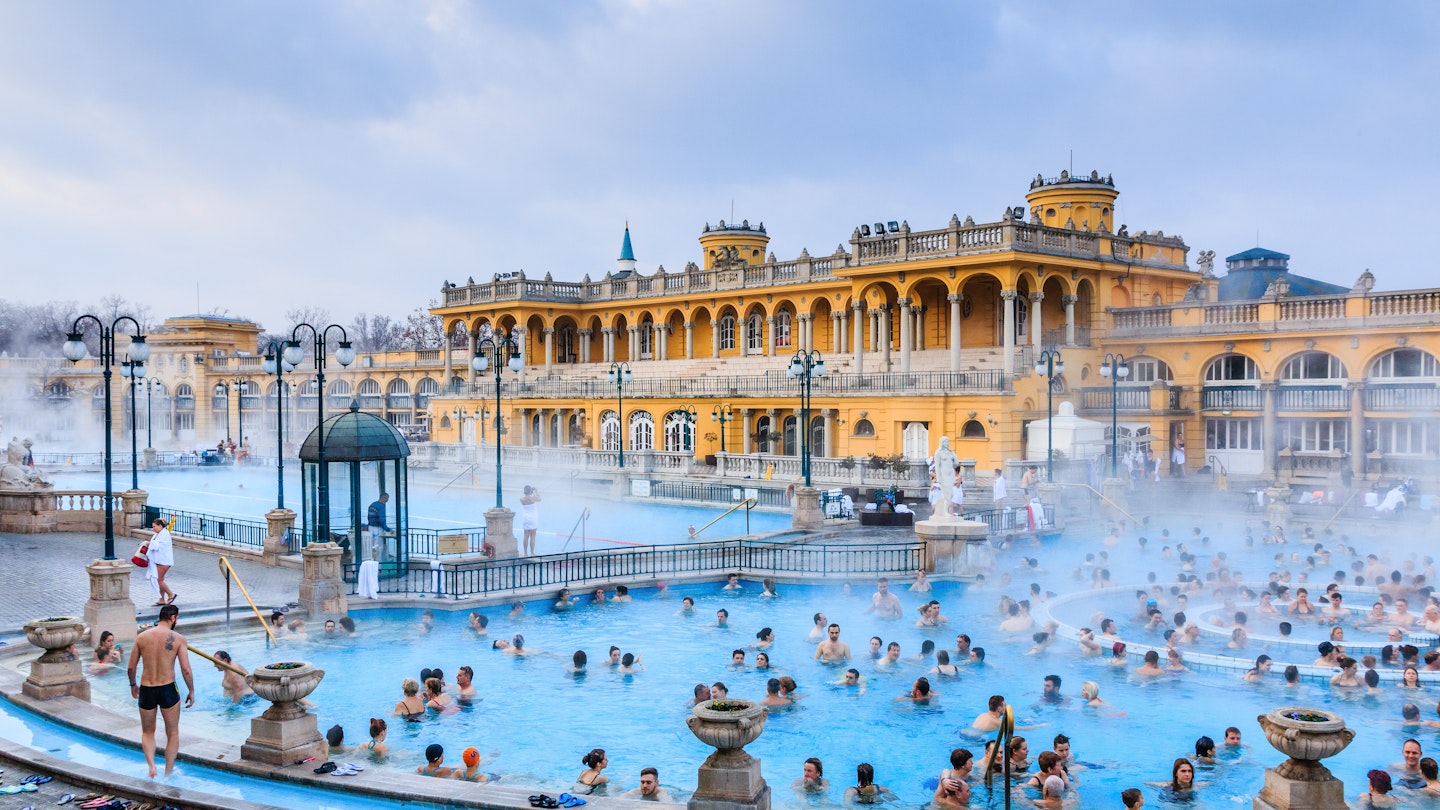Welcome to Budapest, the “World’s Spa Capital.” In this captivating city, nothing feels more relaxing than plunging into a thermal pool and soaking away your stress in warm, mineral-rich waters.
A landlocked country with an undying love for water, Hungary is blessed with naturally heated springs bubbling up from below. With its famously elegant bathhouses, Budapest is a paradise for those seeking relaxation, healing, and a taste of local culture.
These aren’t just any old baths; they’re architectural marvels, portals to the past, sanctuaries of wellness, social hotspots, and a quintessential part of the Budapest experience. Whether you’re looking to cure what ails you or simply soak up the local way of life, here’s everything you need to know about Budapest’s thermal baths!
Budapest Bathing Across the Centuries
Hungary is filled with thermal springs—more than 1,000 in the country and over 100 in Budapest alone, producing around 40,000 square meters of warm, mineral-rich water daily. Before the Roman conquest, the area around present-day Budapest was inhabited by the Eravisci, a Celtic tribe who named this land Ak-ink (Abundant Water).
Romans established the regional capital of Aquincum and quickly began utilizing Hungary’s thermal springs, as evidenced by the ruins of Roman bathhouses found around the country. The most notable spa in Aquincum was the Thermae Maiores (Great Bath), which offered luxuries such as hot and cold piped water and underfloor heating.
Bathing truly became an integral part of Hungarian culture during the Ottoman Occupation in the 16th and 17th centuries. The Ottomans constructed elegant hammam-style baths featuring octagonal pools with high-domed ceilings, adorned with glass inlays that allowed rays of light to illuminate the water.
Two historic bathhouses—Rudas Baths and Veli Bej Baths—remain in use today, while most of Budapest’s other historic baths, such as Széchenyi Baths and Gellért Baths, were built in the 19th and 20th centuries, during Budapest’s time as the second capital of the Austro-Hungarian Empire.
The Healing Power of Budapest’s Waters
Many bathhouses in Budapest proudly boast the healing properties of their waters. Bubbling up from a network of underground caves, the warm waters are rich in dissolved minerals such as calcium, hydrogen carbonate, magnesium, sodium, sulfate, chlorides, and metaboric acid. More than just pampering, a mineral bath can also be curative.
Studies have shown that soaking in mineral-rich water can help alleviate a range of health problems, including arthritis, muscle pain, slipped discs, circulatory disorders, nerve pain, respiratory illnesses, orthopedic issues, and even hangovers.
Plan Your Visit: Essential Information
When to Go:Most baths operate year-round and are wonderful to visit in every season, but soaking outdoors in winter, while watching steam rise into the air, is particularly magical. Weekends and the winter holidays bring larger crowds, so for a more peaceful experience, consider visiting on weekdays or early in the morning.
Opening Times:Opening times vary by bathhouse, and some now open at night on weekends. It’s advisable to check the current hours before your visit, as most baths have decent on-site dining options, allowing you to spend an entire day relaxing.
Family Considerations:Children must be 14 or older to use the thermal baths, as their cardiovascular systems can be affected by high water temperatures. Pregnant women are also advised against bathing in thermal waters. For family-friendly swimming, consider one of the city’s many open-air lidos.
Etiquette and Rules:Before entering the waters, be sure to take a shower and tie back long hair. Noise levels should be kept to a minimum, as many visitors come for relaxation and healing. Also, avoid prolonged soaking to prevent light-headedness; general advice is to limit your time to about 20 minutes at a time.
What to Bring: Your Bathhouse Essentials
When visiting Budapest’s bathhouses, it’s wise to pack swimwear, a towel, and flip-flops. While bathing accessories are available for rent or purchase on-site, bringing your own is usually more economical. Showers and hair dryers are available, so don’t forget your personal cleaning products.
The Best Baths to Visit
Your choice of bath depends on personal preferences, but below are our top recommendations:
Gellért Baths
For a stunning Art Nouveau experience, Gellért is a must-visit. With colorful tiles and mosaics, stained-glass windows, and marble columns, bathing here feels like entering a royal setting.
The lowdown:Location: Buda side, next to Gellért Hill.
The vibe: Elegant and historic.
Selling points: Stunning Art Nouveau design.Open at night? No, closes at 7pm or 8pm in high season.
Széchenyi Baths
As one of the largest spa complexes in Europe, Széchenyi is also among Budapest’s most popular baths. Imagine sunflower-yellow walls encasing steaming outdoor pools, with scenes of locals engaged in chess games from within the water.
The lowdown:Location: City Park (Városliget).
The vibe: Grand and lively.
Selling points: Lovely outdoor pools and a beer bath section.
Open at night? No. The baths close at 7pm or 8pm in high season, but special evening events are held most Saturdays.
Rudas Baths
Rudas has roots dating back to the Turkish conquest but has been fully renovated to offer modern comforts. The rooftop hot tub provides stunning views of the Pest skyline.
The lowdown:Location: Buda side, near Elizabeth Bridge.
The vibe: Ottoman charm with contemporary touches.
Selling points: Rooftop hot tub.
Open at night? Yes, on Fridays and Saturdays.
Lukács Baths
Lukács is a tranquil destination offering an authentic thermal bath experience, away from the tourist trails. Known for its medicinal waters, visitors can also experience a beer bath here.
The lowdown:Location: Buda side, close to Margaret Island.
The vibe: Local and calm.
Selling point: Atmosphere of health and relaxation.
Open at night? No, closes at 7pm or 8pm in high season.
Veli Bej Baths
Less crowded than the more famous baths, Veli Bej offers both historical charm and modern conveniences. While there are no outdoor pools, the interior still retains beautiful original features.
The lowdown:Location: Buda side, near Margaret Island.
The vibe: Quiet and intimate.
Selling points: Rich Ottoman history paired with modern facilities.
Open at night: No, closes at 9pm.





